Key takeaways:
- Different audio formats, such as vinyl, MP3, and FLAC, evoke unique emotional responses and enhance the listening experience.
- Choosing the right format impacts sound quality, preserving the nuances and details of music for better enjoyment.
- Formats like WAV and FLAC offer uncompressed quality essential for music production and immersive listening.
- Practicality and accessibility of formats like MP3 balance convenience with nostalgia in personal music collections.
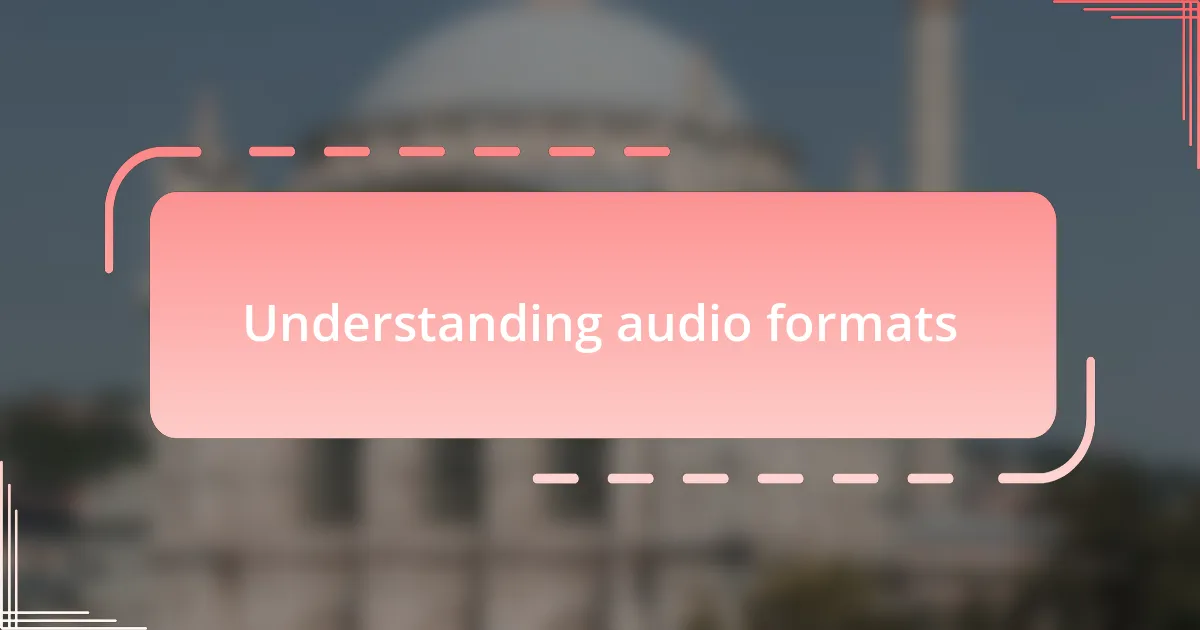
Understanding audio formats
Understanding audio formats is essential for anyone passionate about sound and its preservation. I’ve often found myself pondering, what makes one format resonate with our emotions more than another? Whether it’s the warmth of vinyl or the crispness of a high-quality digital file, each format brings a distinct character to the audio experience that can evoke powerful memories and feelings.
Different audio formats have varying qualities and applications, and here’s where my journey really begins. I remember the first time I listened to an old jazz record—a scratchy vinyl that transported me back to a smoky club in the 1940s. It was that unique crackle and pop that added an authenticity I couldn’t resist. This personal connection illustrates how the right format can enhance not only the listening experience but also our emotional engagement with the music.
Moreover, the debate between lossy and lossless formats has always intrigued me. It’s fascinating to think about how a simple choice between MP3 and FLAC can affect the nuances of what we hear. Have you ever listened to your favorite song on both and noticed the subtle differences? In my experience, the richness of lossless formats often reveals hidden layers in the music I thought I knew, deepening my appreciation for the artistry behind it.

Importance of audio formats
Choosing the right audio format is crucial because it directly impacts the quality of sound we experience. I vividly remember the first time I played an orchestral piece on a high-resolution audio format; the clarity of each instrument was astonishing. It made me realize that every note, every pause, and the subtle harmonies could transport me into the very heart of the performance. Have you ever listened to a song where the details felt alive? That’s the magic of an appropriate audio format.
Audio formats also ensure the longevity of our audio heritage. Just think about the countless hours of recording that go into a single album. As I wandered through an archival vault filled with cassettes and reels, I felt a strong urge to protect those sounds from fading away. Formats like WAV or FLAC not only capture the essence of those recordings but also preserve them in a way that can be enjoyed for generations. Isn’t it comforting to know that by choosing the right format, we contribute to the legacy of artists long gone?
On a practical level, different formats suit different environments and devices. I often find myself juggling formats based on where I’m listening—whether it’s a casual drive with friends or a solitary evening at home. The choice between a portable MP3 and a more nuanced lossless format can transform the experience. Have you ever found the atmosphere changing with the audio quality? I know I have, and it illustrates just how integral the right audio format is to fully enjoy and appreciate sound.
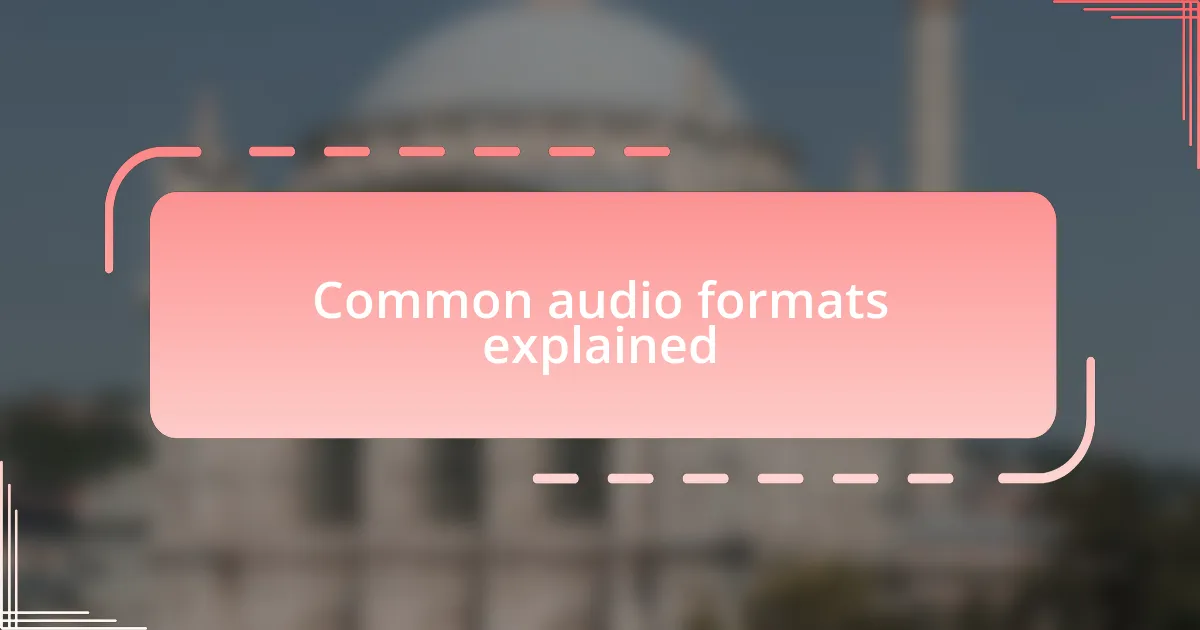
Common audio formats explained
When discussing common audio formats, it’s essential to highlight WAV, a staple for high-quality sound. I recall a recording session where we opted for WAV, capturing each nuance of our instruments in stunning clarity. It almost felt like being in a room with the performers, emphasizing how this uncompressed format preserves a rich auditory experience. Have you ever felt the difference between a live recording and a compressed track? It’s like comparing a freshly brewed cup of coffee to one from a vending machine.
Another widely recognized format is MP3, which many of us have used for years. I remember my first digital music collection, painstakingly ripped from CDs into MP3 files. Despite its convenience and smaller file size, it sometimes lacks the depth found in other formats. Have you ever noticed how certain songs just don’t hit the same when they’re compressed? That’s the trade-off for portability, but it certainly makes playlists easier to manage.
FLAC, or Free Lossless Audio Codec, is another favorite of mine, especially when I want to indulge in an immersive listening experience. I recall coming home on a rainy evening, pouring myself a cup of tea, and losing myself in a carefully curated FLAC playlist. The weather outside faded into the background as the music wrapped around me in full detail. Isn’t it amazing how the right format can elevate an everyday moment into something special?
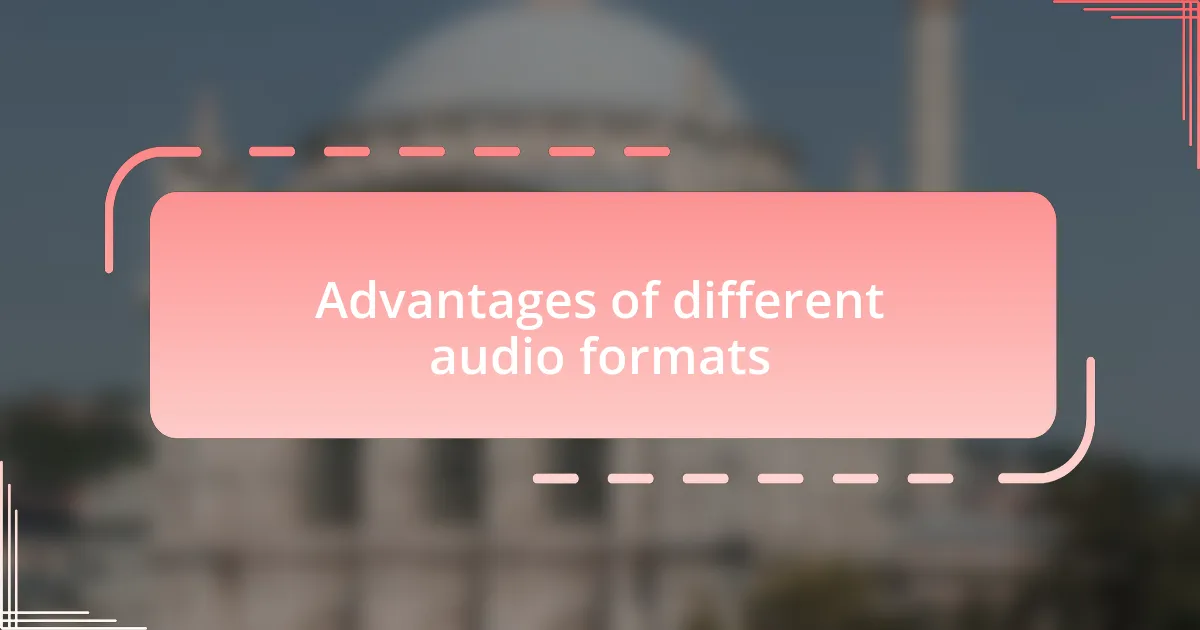
Advantages of different audio formats
When I think about audio formats, I can’t help but appreciate the distinctive advantages each one brings to the table. For instance, I often turn to AAC (Advanced Audio Codec) when I’m streaming music on the go. The sound quality is surprisingly rich for its file size, making it perfect for those moments when I’m jogging in the park. Have you ever been caught off guard by a song that just resonates perfectly with your surroundings? AAC has that effect; it balances quality and efficiency beautifully.
On the other hand, OGG Vorbis is a format I’ve recently explored, especially when diving into indie music. It feels like a hidden gem, offering a great compromise between file size and audio quality without the licensing restrictions of MP3. The first time I listened to an OGG track, I was amazed by its warmth and clarity. It felt as if I were rediscovering familiar tunes, making me wonder if I had been missing out all along. How many hidden treasures are out there in less mainstream formats?
Lastly, the DSD (Direct Stream Digital) format offers a tantalizing experience for audiophiles. I still remember the chills I felt during a listening session of classical music in DSD. The dynamic range and detail were astonishing, making me feel as if I were seated in a grand concert hall. Is there anything more satisfying than experiencing music the way the artist intended? DSD captures the essence of sound in a way that speaks to the heart, showing how format can truly elevate audio experiences.
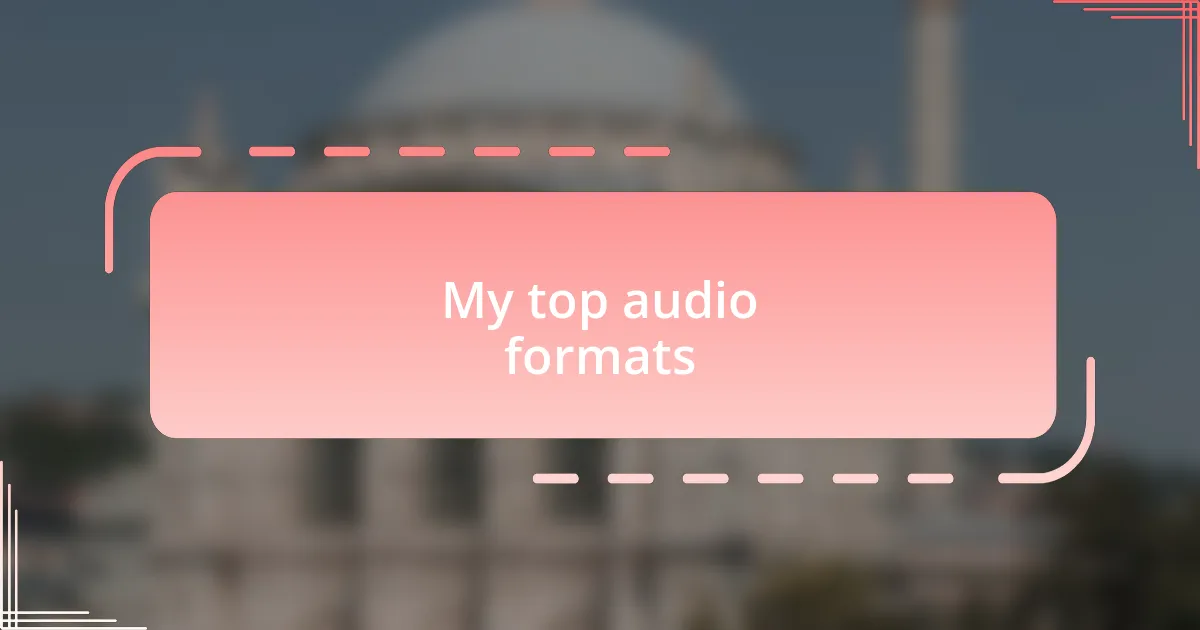
My top audio formats
One of my go-to audio formats is FLAC (Free Lossless Audio Codec). I’ll never forget the first time I played a familiar album in FLAC; it was like hearing it for the first time. The depth and detail were so profound that I felt drawn into the music, almost as if I could reach out and touch the instruments. Have you ever had an experience where the quality of sound transformed your perception of a song? I certainly did that day.
Then there’s MP3, a classic in the world of audio formats. While some might consider it outdated, I can’t deny the nostalgia it brings me. It reminds me of late-night study sessions, creating mixtapes for friends, and those road trips with the perfect soundtrack. The convenience of MP3 allows me to carry countless albums in my pocket, ensuring that I always have my favorites at hand. Doesn’t it feel great to have instant access to the music that defines our moments?
Lastly, I’ve had some delightful experiences with WAV files, especially during my moments of music production. Whether it’s layering tracks or simply enjoying the raw sound, the uncompressed nature of WAV provides an incredible listen. It’s the difference between peering closely at a painting versus seeing a high-resolution image—each nuance becomes apparent, and the excitement of discovering fine details keeps me coming back for more. Have you ever tried working with a raw audio format and felt that same rush? It’s exhilarating.
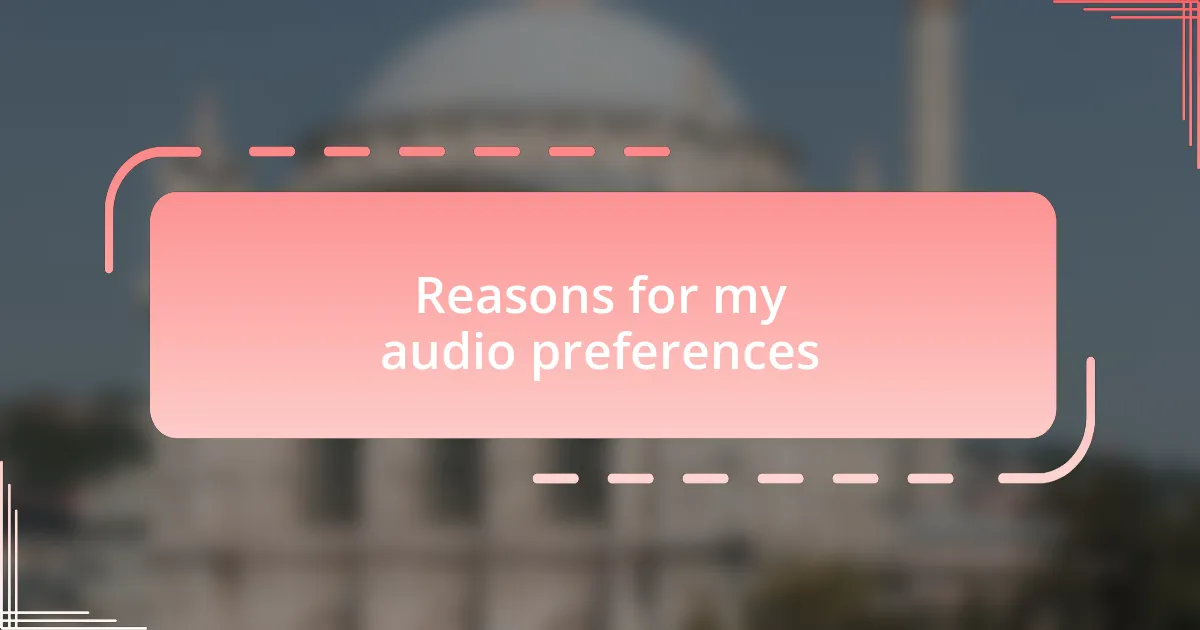
Reasons for my audio preferences
When I think about my audio preferences, it often comes down to the experience that each format provides. For instance, the first time I heard a live jazz recording in a high-resolution format, it felt like I was transported to the front row of the concert. The nuances of the saxophone and the subtle brush of the drummer created an atmosphere that simply couldn’t be matched by lower-quality files. Have you ever felt that intensity from a recording? I know I have, and it changed how I perceived live music forever.
Then there’s the practicality of formats like MP3. I remember filling my playlist with songs before a long trip, and the convenience of MP3s made it easy to create the perfect mix-tape soundtrack in no time. While I adore the airy quality of FLAC files, there’s something about the accessibility of MP3s that keeps them close to my heart. It makes me wonder—how many cherished moments have we stored in our devices, crafted from a simple audio format?
WAV files hold a special place in my music-making journey as well. Each time I recorded vocals in that format, I felt a rush of excitement, knowing that I was capturing the purest form of sound. The clarity it offers is like unlocking new possibilities in creativity. Can you relate to that thrill when working with high-quality audio? Every session feels fresh, and that’s what fuels my preference for WAV files in my projects.